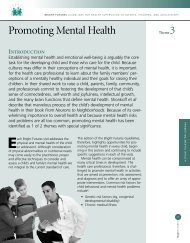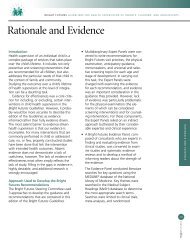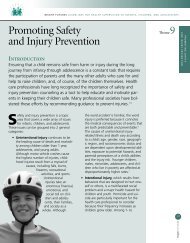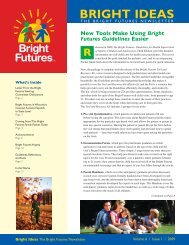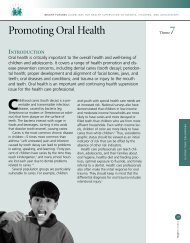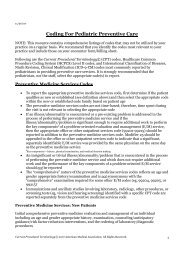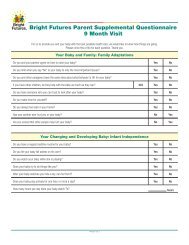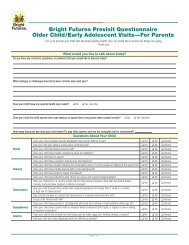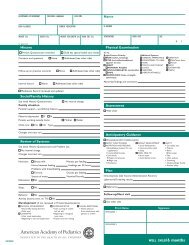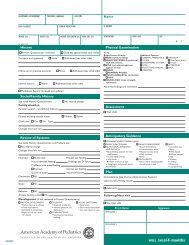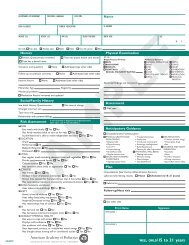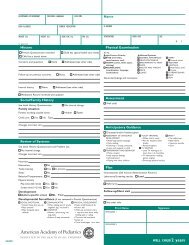POCKET GUIDE - Bright Futures - American Academy of Pediatrics
POCKET GUIDE - Bright Futures - American Academy of Pediatrics
POCKET GUIDE - Bright Futures - American Academy of Pediatrics
Create successful ePaper yourself
Turn your PDF publications into a flip-book with our unique Google optimized e-Paper software.
oral health<br />
■ Assess eating behaviors to determine the infant’s risk for<br />
dental caries (tooth decay). Determine whether the infant<br />
has had a dental visit.<br />
vitamin D and iron<br />
■ For breastfed infants, determine whether the infant is<br />
receiving vitamin D supplementation, and assess the<br />
need for iron supplementation.<br />
Anticipatory Guidance<br />
discuss with Parents <strong>of</strong> all infants<br />
■ gradually introducing their infant to solid textures to<br />
decrease the risk <strong>of</strong> feeding problems, such as rejecting<br />
certain textures, refusing to chew, or vomiting. (it may take<br />
10–15 attempts before an infant accepts a particular food.)<br />
■ understanding that infants will become more interested<br />
in food their parents eat and less interested in breastfeeding<br />
or bottle-feeding. Nevertheless, infants should receive<br />
breast milk, infant formula, or both through the first year<br />
<strong>of</strong> life.<br />
■ <strong>of</strong>fering s<strong>of</strong>t, moist foods as their infant gradually moves<br />
from gumming to chewing foods.<br />
■ <strong>of</strong>fering small pieces <strong>of</strong> s<strong>of</strong>t foods as their infant gains<br />
more control over picking up and holding food.<br />
■ Placing their infant in a high chair (using a safety belt) to<br />
sit with the family during mealtime.<br />
■ serving only 100% fruit juice in a cup as part <strong>of</strong> a meal or<br />
snack, and limiting juice to 4 to 6 oz per day.<br />
■ Avoiding feeding their infant sweetened beverages, such as<br />
sodas and fruit drinks.<br />
■ Providing their infant snacks midmorning, in the afternoon,<br />
and in the evening. (Most 9-month-olds are on the<br />
same eating schedule as the family: breakfast, lunch, and<br />
dinner.)<br />
discuss with Parents <strong>of</strong> breastfed infants<br />
■ encouraging the mother to breastfeed for the first year <strong>of</strong><br />
the infant’s life.<br />
■ Providing vitamin D supplement (400 iu/day).<br />
■ Providing an iron supplement (1 mg/kg <strong>of</strong> body<br />
weight/day) if the infant does not consume sufficient<br />
iron-rich foods.<br />
23<br />
<strong>Bright</strong> FUTURES<br />
Infancy



